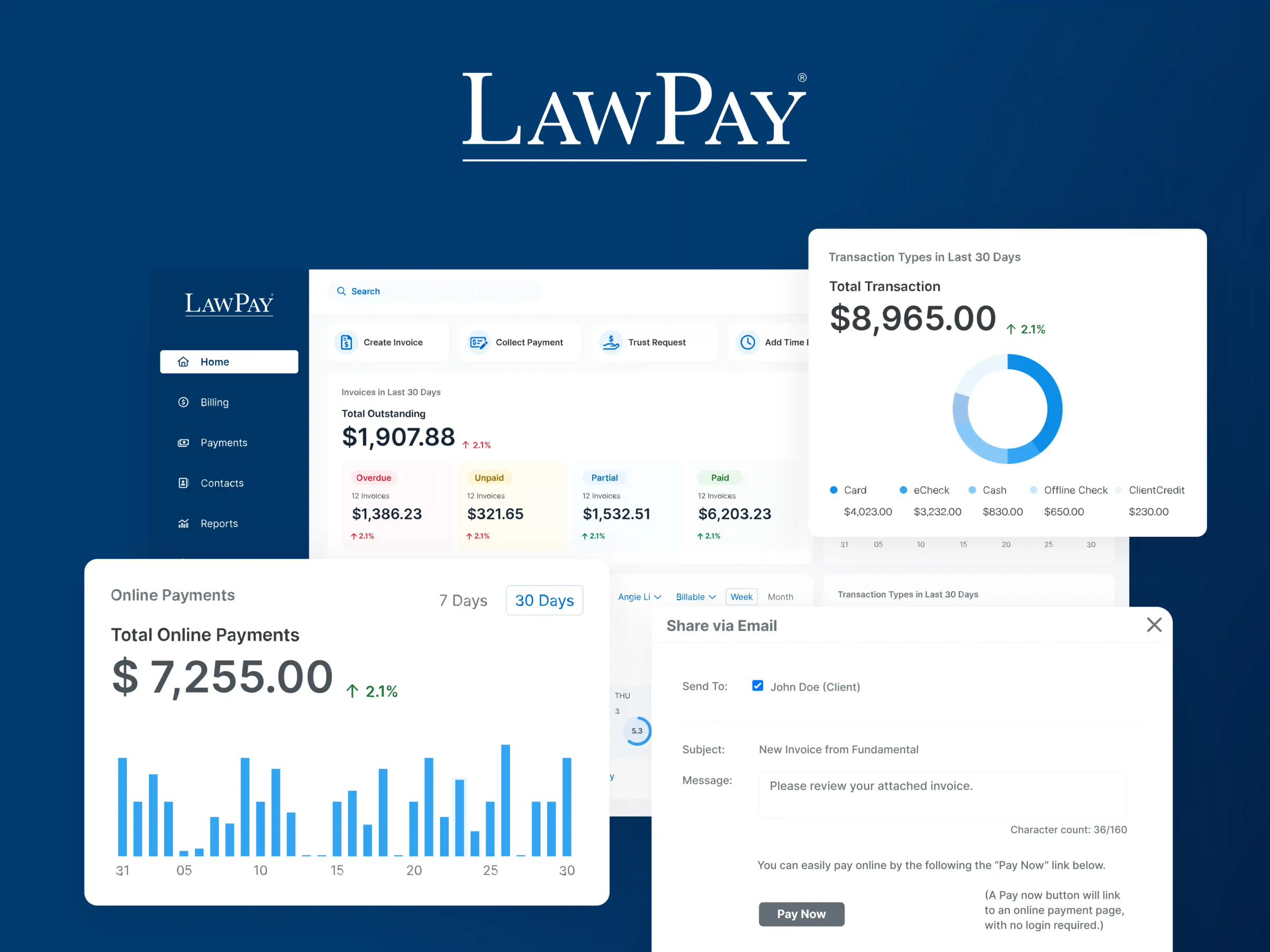While an attorney’s top priority should always be clients, maintaining healthy law firm finances is a close second that is often overlooked. At the end of the day, law firms are a business and just like any other business must be equipped to handle unexpected market changes and prepare for the future. Unfortunately, most law schools don’t prepare lawyers with the financial management skills that are vital to driving revenue, sustaining business, and ultimately better serving clients.
However, learning the basics of financial management and utilizing the latest digital tools can go a long way towards helping your law firm run more efficiently and achieve sustainable long-term growth.
Schedule a demo to see what LawPay can offer your firm.
Book Now
What is Law Firm Financial Management?
Simply put, financial management is a mixture of strategic planning and day-to-day financial practices that help a law firm find short and long-term business success. To go a little deeper, financial management encompasses the planning, directing, organizing, and controlling of a business’s financial operations. This includes things like tracking expenses and cash flow, making budgets, planning for revenue growth, and more. This may be handled by a law firm CFO (Chief Financial Officer), a dedicated accounting team, or by the attorneys themselves in a small or independent operation.
While it may seem a little complicated initially, you don’t have to become a financial expert to handle your law firm’s finances effectively. Many modern tools can help simplify the process and break down the various parts of financial planning into manageable chunks.
Why Correctly Managing Law Firm Finances Leads to Growth
Gaining more clients and ultimately increasing revenue is the end goal of any successful law firm. However, without a solid financial management strategy, these periods of growth can actually create more complexity and problems for the business. Put simply, without an honest understanding of where your money is coming from, how it’s being spent, and where to invest it—it’s easy to lose track of spending and harder to maintain healthy financial growth. To make matters even messier, lawyers have the added responsibility of ensuring their finances follow complicated trust accounting regulations, including maintaining IOLTA compliance.
Creating a financial management strategy includes taking a critical look at where you are in the business life cycle, your cash flow, and other key metrics that help you sustain your business. Beyond improving the efficiency of day-to-day operations, it can also help you find opportunities to invest in marketing to attract more clients, free up funds for new hires, find inefficiencies, and track key law firm KPIs (key performance indicators) that show how well your firm is performing.
Additionally, taking the time to create a sound financial plan can help you find ways to optimize law firm management processes and generate more consistent cash flow, giving you more flexibility and time to better serve your clients.
Key Components of Effective Law Firm Financial Management
While all of the benefits of financial planning and management may sound great at a high level, it can be difficult to know where to start. Here is a breakdown of some of the key elements that make up an effective law firm finance strategy.
Budgeting
Creating a budget is a crucial first step in understanding your financial performance and establishing realistic targets for profitability and growth in both the short and long term. Every law firm’s budget is unique and varies based on what type of law you practice or even how long you’ve been practicing.
A basic law firm budget includes a comprehensive list of expenses, startup costs, recurring subscriptions, and projected revenue. An accurate budget helps you set honest and clear forecasts of your profits, which in turn helps you plan for everything from seasonal slowdowns and upcoming fees to setting fee structures and managing your caseload.
Managing Cash Flow
Managing your cash flow is essential to support your firm’s needs in the short-term and improve your financial outlook in the future. However, finding ways to improve cash flow can be tricky—lawyers often don’t get paid immediately for their work and often have to wait for a settlement to be finalized before getting paid.
The best way to get a handle on cash flow is to track it. By identifying the short-term patterns in your firm’s cash flow, you can hone in on what’s profitable, where there are inefficiencies in your billing process, and other factors that can help you make projections for the future.
One key way to improve cash flow is by using a modern legal payment solution to implement more accurate and timely billing. Legal billing software can significantly improve the way law firms accept payment and help streamline (or even automate) many aspects of the accounting process. Leveraging the right technology solutions ultimately frees you up to spend more time serving clients or on strategic work.
Long-Term Planning
Long-term financial planning refers to preparing for financial activities that take place over a year or even further out. This doesn’t just include paying upcoming financial obligations like loans or dues but could also include planning for a long-term event like taking on a lengthy case that won’t pay out for a year or more. A strategic financial plan takes these delayed payments into account and gives you an understanding of what kind of financial growth you’ll need to maintain in order to fulfill your obligations and achieve business success. Planning for the long-term is also helpful when managing your firm’s tax deductions and figuring out your tax obligation.
The best way to start a long-term plan is to leverage your financial data from previous years to create cash flow and revenue forecasts. If you’re not tracking that data yet, now is the perfect time to start. Forecasting, combined with other aspects of strategic long-term financial planning, is integral to making sure your firm continues to grow in the years to come.
Profitability Analysis
A profitability analysis is a tool that allows law firms to review their financial performance, which can help identify growth opportunities and areas for improvement. Put another way, this analysis looks at the utilization rate of lawyers and staff, understanding their output in relation to the number of billable hours. Tied to this is also getting a picture of your firm’s realization rate, the number of hours that are put into a task versus the actual fees that are collected.
Any number of metrics can go into a firm’s profitability analysis outside of just casework, such as the time spent following up billing and collections, administrative tasks, or other day-to-day processes. The ultimate goal of performing a profitability analysis is to find ways to increase efficiency and utilization without sacrificing client satisfaction or your staff’s well-being.
Financial Reporting
Financial reporting is a method of tracking, analyzing, and communicating important information about the financial health of your business. Most financial reports are designed to conform to the U.S. Generally Accepted Accounting Principles (GAAP) standards for consistency. Whether the report is used externally to satisfy legal compliance requirements or internally within the firm, there are several key elements that a law firm should include:
Income Statement
An income statement shows all revenue, expenses, and net income over a fixed period. This report gives you a straightforward picture of how the law firm is performing financially.
Balance Sheet
A balance sheet shows your law firm’s financial standing by listing its assets, liabilities, and equity. This report is useful because it shows your law firm’s ability to fund future growth and its net worth.
Cash Flow Statement
A cash flow statement tracks how much money is coming in from billed hours versus how much it is spending. By analyzing a cash flow statement, you can gain an honest understanding of your law firm’s ability to meet its cash needs over a given period of time.
Retained Earnings Statement
A retained earning statement shows the total earnings a law firm has accumulated and kept in the business since its inception. Its purpose is to show how the owner’s equity has changed over time, and how much is available to reinvest in the business.
Why You Should Use Legal Payments Software for Financial Management?
Law firm finance is extremely complex, and trying to manage billing and accounting while actually doing casework and keeping on top of client communication is no easy task. But whether you’re a big firm with a dedicated accounting team or a small independent practice, law firm accounting and financial management is a must for your continued success. This is why leading practices increasingly rely on cloud-based legal billing solutions to streamline and optimize their financial management.
Modern legal payment platforms like LawPay come with a myriad of built-in features that help law firms improve cash flow by modernizing billing, payment, and A/R management processes. Flexible, secure digital payment options help lawyers get paid quicker and more consistently while making the experience more convenient for clients.
Additionally, dedicated legal payment platforms are designed to be fully compliant with IOLTA rules and come with a number of other helpful time-saving features that can help optimize a law firm’s financial management. Also, integrations with frequently-used accounting software and case management solutions let you combine your operational and financial data which can then be used for forecasts, reporting, budgeting, and more.
Improve Your Firm’s Financial Health with LawPay
Schedule a demo to see what LawPay can offer your firm.
Book Now
LawPay is a state-of-the-art legal technology trusted by thousands of legal practitioners across the country. In the face of modern market uncertainty and change, revolutionizing your law firm accounting and financial management practices is key to ensuring your business meets modern client expectations and is ready for whatever changes come your way.
To learn how using LawPay to accept and manage payments at your practice can contribute to a healthier financial future, schedule a demo today.
About the author

The LawPay Team
